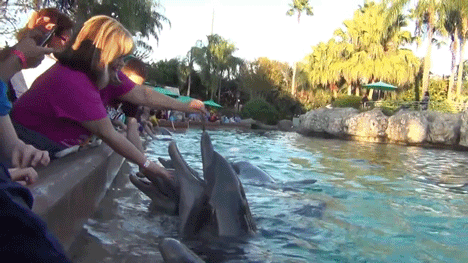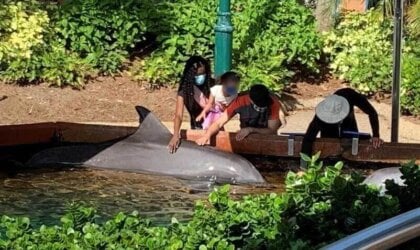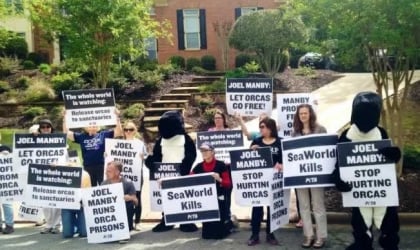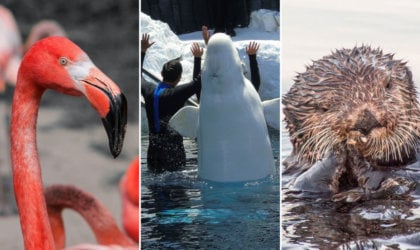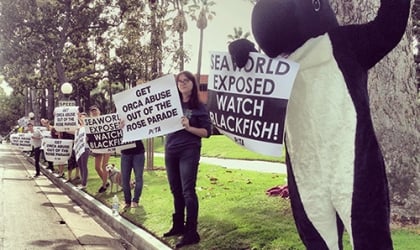In their natural environment, dolphins are able to swim vast distances each day, form decades-long social bonds, explore new areas, and help each other find mates. Their lives are rich, complex, and—most importantly—their own.
Here are just some of the many reasons why dolphins belong in the ocean, not at SeaWorld:
1. Dolphins Help Each Other Find Mates
Dolphins have large social networks and even form alliances with one another to help find mates and fight off competitors. But at SeaWorld, they’re used as breeding machines. Male bottlenose dolphins are masturbated, and females are torn out of the water and sometimes drugged so they can’t fight back while staff shove tubes filled with semen into their uteruses. Everything about these traumatizing practices goes against the natural breeding habits of dolphins. Yet these appalling acts of abuse are the backbone of SeaWorld’s breeding program.
2. Dolphins Are the ‘Einsteins’ of the Animal World
Dolphins are keenly intelligent and can solve complex problems. They have distinct personalities and a strong sense of self and can think about the future. SeaWorld uses this intelligence to train dolphins to perform cheap “tricks”.
3. Dolphins Need Their Freedom
In nature, dolphins swim vast distances every day with their extended families, exploring new places and seeking out adventures and pursuits. Dolphins at SeaWorld are confined to tiny tanks and see the same concrete walls every day of their lives. Dolphins navigate by echolocation, but in pools, the reverberations from their own sonar bounce off the walls.
4. Dolphins Die Early in Tanks
Bottlenose dolphins can live at least 40 years in the ocean and average approximately 25 years, but many captive-born dolphins live half as long as those born in their natural habitats. More than 300 dolphins (not counting orcas) have died at SeaWorld parks, many prematurely.
5. Cheap Tricks Cause Injuries
In 2008, Sharky, a captive dolphin at SeaWorld’s Discovery Cove, was fatally injured while performing an aerial trick. He collided in mid-air with another dolphin and subsequently died. And in 2012 at SeaWorld’s San Antonio facility, two dolphins performing a jumping trick crashed, ejecting one from the tank onto the concrete walkway below. The dolphin was bleeding and helpless as guests looked on.
6. Touch Tanks Are Trouble
Interactive programs that allow the public to pet, kiss, or even “ride” dolphins invade the animals’ already diminished worlds and are dangerous for the animals and human participants. Dolphins in “petting pools” can become neurotic and anxious as a result of constant poking and prodding and can become sick from exposure to bacteria. The U.S. Department of Agriculture has cited SeaWorld for several instances in which members of the public, including children, were bitten and injured at the facility’s dolphin-petting pools.
7. Families Are Left in Tatters
Dolphins communicate with each other through distinct whistles and body language. They live in pods and have their own family histories. The constraints of captivity deny dolphins their natural dynamics.
8. Captive Dolphins Are Stressed and Distressed

Captive dolphins demonstrate a variety of stress-driven behavior, including self-inflicted injuries, aggressiveness, and neurotic behavior. Dolphins are often dosed with antacids to treat stress-induced ulcers.
Learn more about cruelty at SeaWorld on The PETA Podcast:
Listen to more episodes on iTunes, Stitcher, and Spotify! Subscribe for new episodes.
You can help the dolphins imprisoned at SeaWorld by never visiting the theme parks and by sharing with your friends and family information on why they shouldn’t visit them, either.
You can also urge SeaWorld to implement a firm and rapid plan to release all the captive marine animals to sanctuaries today.

